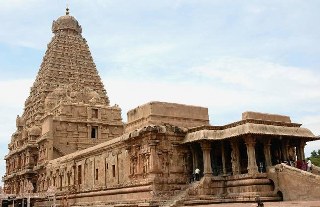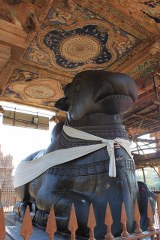History of Brihadeeswarar Temple
Thanjavur Brihadeeswara temple is one of the most ancient temple, situated in the city of Thanjavur in Tamil Nadu, India. Thanjavur named after the legendry asura "Tanjan", is one of the ancient temples in India. In ancient days, Thanjavur known as “The rice bowl of Tamil Nadu,” was an important city to the ancient Cholas. It was remade by the Cholas from a collection of villages into a major temple center 1000 years ago, with the construction of the Brihadisvara Temple in the center of the city, and the city then built up around it. Thanjavur had the distinction of being specifically constructed as a religious city with the temple centermost.
The Brihadeeswarar Temple was built to display the emperor's vision of his power and his relationship to the universal order. On the 275th day of his 25th regal year (1010 A.D) Raja Raja Chola handed over a gold-plated kalasam (copper pot or finial) for the final consecration to crown the vimana. Located in the nerve centre of the Chola empire, the temple attracted musicians, scholars, craftsman and merchants. Most notably, it served as a platform for the dancers who excelled in the traditional dance form of Bharatha Natyam. The Cholas were ousted by the Pandyas. The Pandyas were followed by the Vijayanagara empire. In 1535, the Vijaynagar king installed a Nayak king, hence, the era of Tanjore Nayaks which lasted till mid-17th century. In 1674, the Marathas conquered Tanjore. Later, like the rest of the country, Thanjavur too fell into British hands. The inscriptions and frescoes on the walls of the temple record the rise and fall of the city's fortunes.
Brihadeeshwara temple or the Big temple in Tanjore is the best example of excellent workmanship, grandeur and it has stood the testimony of time with its magnificent central  dome which is a great attraction for one and all. The Brihadeshwar Temple, dedicated to Lord Shiva, was built by King Rajaraja I in the 11th century to celebrate a military victory. The temple is a tribute as well as a reflection of the power of RajaRaja Chola I. The temple is most famous due to its uniqueness as among the greatest glories of the Indian architecture. The complex that houses the main sanctum is known as the 'Periya Kovil'. It is located amidst the fortified walls that were added to the building in the 16th century. This architectural masterpiece has been designated as UNESCO World Heritage Site. The temple is built over 29 square base and is surrounded by moat on two sides and Grand Anaicut river on the other side. The walls of the complex are adorned by beautiful paintings belonging to the Chola and Nayak period. The Siva Lingam here is gigantic, more than 12 feet tall. The Nandi facing the sanctum is also 12 feet in height and the dwarapalaks (the guardians deities of temple) and deities around the main shrine look elegant.. The main attraction here is the huge tower above the sanctum which is about 216 feet. The tower stands tall and one can see this fabulous structure even as one enters Tanjore.
dome which is a great attraction for one and all. The Brihadeshwar Temple, dedicated to Lord Shiva, was built by King Rajaraja I in the 11th century to celebrate a military victory. The temple is a tribute as well as a reflection of the power of RajaRaja Chola I. The temple is most famous due to its uniqueness as among the greatest glories of the Indian architecture. The complex that houses the main sanctum is known as the 'Periya Kovil'. It is located amidst the fortified walls that were added to the building in the 16th century. This architectural masterpiece has been designated as UNESCO World Heritage Site. The temple is built over 29 square base and is surrounded by moat on two sides and Grand Anaicut river on the other side. The walls of the complex are adorned by beautiful paintings belonging to the Chola and Nayak period. The Siva Lingam here is gigantic, more than 12 feet tall. The Nandi facing the sanctum is also 12 feet in height and the dwarapalaks (the guardians deities of temple) and deities around the main shrine look elegant.. The main attraction here is the huge tower above the sanctum which is about 216 feet. The tower stands tall and one can see this fabulous structure even as one enters Tanjore.
The temple architecutre marvel comprises of bundles of surpries: Shadow Disappears at noon
The most intersting part of this temple is the shadow of the temple, which surprisingly never falls on the ground at noon. The Brihadeshwar Temple is one of the tallest temples in the world and is so designed that the viman does not cast a shadow at noon during any part of the year.
First All Granite Temple
Brihadeshwar Temple is the first complete granite temple in the world. Granite is not found in the surrounding areas. It is not known where this massive granite was brought from. The absence of a granite quarry within a 100km radius of the temple require logistics of epic proportions to get the stone to the construction site. As hard as it was to find, Granite is harder to carve. Yet the great Chola wanted a the temple to be covered with the most intricately designs; unlike the pyramid which possesses extraordinary dimensions but nary an artistry.
Till Date its the tallest temple
The temple was built at a fair clip, completed in mere 7 years, amounting to moving and placing almost 50 tons of rock each and every day, not to forget carving and aligning it. When the Brihadeeswara temple was completed in 1003 CE, it was the tallest temple in India by an order of magnitude of 10. A thousand years later, standing at 216 feet, it is still the tallest temple in India. Atop the soaring vimaana –the tower above the main temple and a word that translates to “airplane”– is a capstone that weighs 80 tons. The best thing in the chola temples is that the tower lies over the sanctums has more elevation as compared to the towers set over the gopuram (tower) that could be found at the entrance. After dusk, when the temple is been illuminated, its topmost light over the dome seems not less than another planet glowing and coming closer to the earth. This attraction is the tallest in its line that draw thousands of people to its area
Musical Pillars
At the entrance of sanctum sanctorum, one can see the two idols of Ganesha in the corridor. On taping the two, you will feel the sound traveling through stone in one idol and through metal on the other. The main hall of the temple is said to have been used by the dancers and musicians performing in service of Shiva. There are some musical pillars producing different sounds when tapped.
Festival
The day of the Ruling star, satabhishag is treated as a festival day every month as it symbolizes the ruling star at the time of birth of Rajaraja. The temple is also the venue of the annual festival that is celebrated here for the period of nine days in the month of Visaka according to the Hindu calendar. The deity is bathed with the water soaked with the fragrant Champaka flower. The temple demonstrates the Dravidian style of architecture, which was immensely popular during that time. The frescoes that adorn the ceilings of the temple are simply amazing, ornamenting the interior as well as exterior of the temple with its beauty. Today, the temple is a great and unique place where people come and worship Lord Shiva.
Architecture
The Brihadeeshwara temple has over a 29 sq.m base. It has a soaring vimana (Srivimana) and a relatively short gopuram. The inner sanctum and the gopuram were constructed over a period of 12 years from a single piece of granite weighing around 80 tonnes. The dome was hauled into place along a 4-km earthwork ramp. The Srivimana or the central vimana has 16 tiers rising to a height of 216 ft, one of the tallest in the world. It symbolizes Mount Meru. The presiding deity is Shiva in the form of a Lingam called Peruvudaiya, Rasjarajeshwaramudvya. The massive Lingam is housed in a huge 2-storey garbhagriha. The inner wall of the garbhagriha or the sanctum sanctorum has sculptures of 108 dance poses called karmas performed by Lord Shiva himself. A huge statue of Nandi measuring 6 m length and 3.7 m in height faces the inner sanctum. The statue of Nandi is a monolith and weighs 25 tonnes. It is, in fact, one of the largest Nandi statues in India. Before you enter the sanctum sanctorum, you will see the two idols of Ganesha in the corridor. On tapping the two, you will feel the sound traveling through stone in one idol and through metal on the other. There is a 16.5m (55ft) high temple dedicated to Lord Subrahmanya that is considered to have some of the best carvings in South India.
Note
The corridor is peaceful and welcoming and unlike other temples does not have shops. The Brihadeeswara temple is one of the few great Indian monuments listed in UNESCO's World Heritage list of historical sites and monuments.